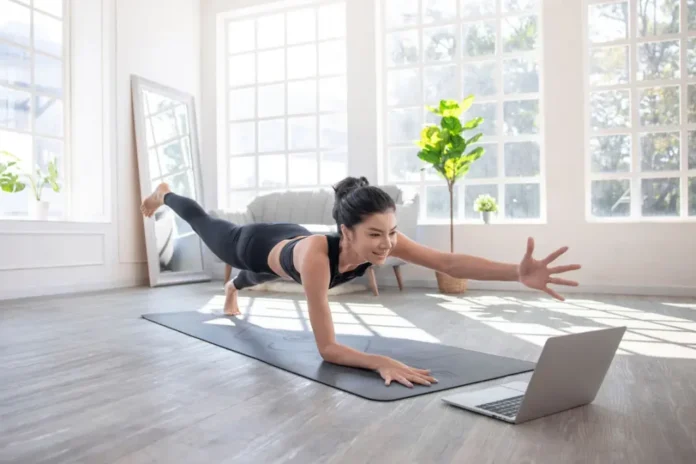Starting yoga as a beginner can feel a bit confusing, especially with so many poses and techniques to learn. The good news is that yoga for beginners online makes it easy and flexible to get started. You can practice from the comfort of your home, at your own pace, without feeling rushed.
Online yoga classes are perfect for those with busy schedules or anyone who prefers privacy. They offer clear, step-by-step instructions and often include beginner-friendly poses to help you build strength, improve flexibility, and feel more relaxed. Plus, you can choose classes that match your fitness level, whether you want gentle stretches or a more active flow.
In this blog, you’ll discover simple tips, beginner poses, and helpful resources to kickstart your yoga journey. Whether you want to ease stress, boost your energy, or simply move your body, online yoga is a great way to experience the benefits without needing to visit a studio.
1. Why Yoga at Home Works Well for Beginners
Starting yoga online offers several benefits, especially if you’re new to it.
- Convenience and Comfort: You can practice anytime without worrying about commuting or class timings.
- Pace Yourself: You can pause, rewind, or repeat sessions, allowing you to learn at your own speed.
- Cost-Effective: Online yoga classes are often more affordable than in-person sessions.
- Privacy: You can practice without feeling self-conscious, which is helpful for beginners.
2. Essentials for Your Online Yoga Practice
You don’t need fancy gear to get started. Here’s what you’ll need:
- Yoga Mat: A non-slip mat provides stability and comfort.
- Comfortable Clothing: Choose breathable, stretchable fabric.
- Internet Connection & Device: A stable connection ensures you can follow the class without interruptions.
- Water Bottle & Towel: Stay hydrated and wipe off sweat during practice.
- Optional Props: Blocks, straps, or cushions can support you in certain poses.
3. Beginner-Friendly Yoga Styles to Explore
Choosing the right yoga style is key to enjoying your practice. Here are a few beginner-friendly options:
- Hatha Yoga: Emphasizes fundamental poses and breath control techniques.
- Vinyasa Yoga: Involves flowing movements with synchronized breathing. It’s a bit faster but still suitable for beginners.
- Yin Yoga: A slow practice that involves holding poses longer to stretch deeper muscles and improve flexibility.
- Restorative Yoga: Uses props to help you hold gentle poses for relaxation.
4. Simple Yoga Poses to Get You Started
Here are some beginner poses you can practice at home:
- Mountain Pose (Tadasana): Improves posture and balance.
- Cat-Cow Stretch (Marjaryasana-Bitilasana): Enhances spine flexibility and relieves back tension.
- Child’s Pose (Balasana): Stretches the back and relaxes the body.
- Downward-Facing Dog (Adho Mukha Svanasana): Strengthens arms, legs, and core while stretching the body.
- Seated Forward Bend (Paschimottanasana): Increases flexibility in the hamstrings and lower back.
Tip: Hold each pose for 30-60 seconds and focus on deep, steady breathing.
5. Breathing Techniques (Pranayama) for Relaxation
Breathing exercises help calm your mind and boost your yoga practice. Try these simple techniques:
- Diaphragmatic Breathing: Breathe deeply into your belly, expanding it as you inhale. This reduces stress.
- Alternate Nostril Breathing (Nadi Shodhana): Inhale through one nostril and exhale through the other. This balances the nervous system.
- Ocean Breath (Ujjayi): Inhale and exhale slowly through your nose, slightly constricting the throat. It creates a calming ocean-like sound.
6. Tips for Practicing Yoga Safely and Effectively
As a beginner, keeping safety in mind is important:
- Warm Up: Start with gentle stretches to loosen your muscles.
- Listen to Your Body: Don’t push into discomfort. Yoga should feel good, not painful.
- Take Breaks: Rest in Child’s Pose if you feel tired.
- Consistency Matters: Practicing regularly, even for 15-20 minutes, yields better results than occasional long sessions.
- Stay Hydrated: Have water before and after your yoga session.
7. Creating a Yoga Routine at Home
Incorporating yoga into your daily routine:
- Set a Schedule: Practice at the same time each day to form a habit.
- Choose a Quiet Space: Practice in a calm, uncluttered area.
- Start with 20-30 Minutes: Gradually increase the duration as you become comfortable.
- Mix Styles: Combine slow, restorative sessions with more dynamic ones to balance strength and relaxation.
8. Nutrition and Hydration Tips for Yoga
Good nutrition supports your yoga practice.
- Pre-Yoga Meal: Eat a light snack (e.g., banana or nuts) 30-60 minutes before practice.
- Stay Hydrated: Drink water before and after yoga.
- Post-Yoga Snack: Enjoy a protein-rich snack (e.g., smoothie or yogurt) to aid recovery.
9. Staying Motivated for Consistent Practice
Maintaining consistency is the key to seeing results.
- Track Your Progress: Use a journal or app to log your sessions.
- Join a Community: Connect with other yoga enthusiasts online for support.
- Try Challenges: Participate in 30-day yoga challenges to stay motivated.
- Celebrate Milestones: Acknowledge your improvements, whether it’s holding a pose longer or feeling more flexible.
Enjoy Your Yoga Journey at Home
Practicing yoga for beginners online gives you the freedom to build strength and flexibility on your own terms. With consistency, you’ll see improvements in both your physical and mental well-being.
To get started with expert-led classes and a range of yoga styles, check out Power Flow Yoga—they offer accessible and guided online sessions perfect for beginners.


